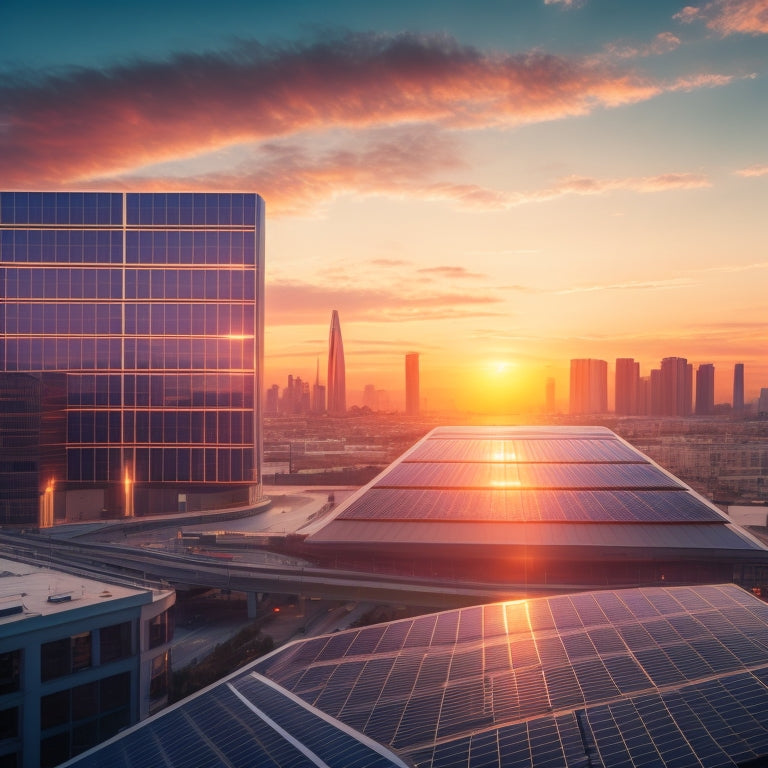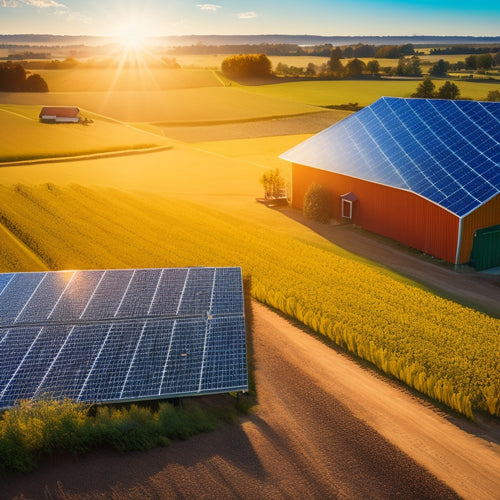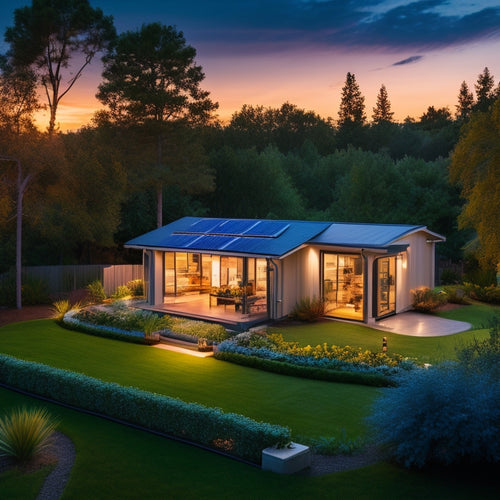
Implementing Solar Panels on Large Buildings in 3 Steps
Share
You'll implement solar panels on your large building in three key steps. First, assess your roof's condition, evaluating its strength, surface integrity, and drainage system to guarantee it can support the solar panel system. Next, select a suitable solar system by determining your energy generation needs, choosing the right panel type, and configuring the system for maximum energy production. Finally, install and maintain your system by employing advanced techniques, integrating with your building's electrical grid, and scheduling regular maintenance to verify peak performance - and that's just the beginning of releasing your building's sustainable potential.
Key Takeaways
- Assess the building's roof condition, ensuring it can support solar panel weight and withstand environmental conditions.
- Select a suitable solar system, considering energy generation requirements, roof space, and energy efficiency ratings.
- Ensure proper installation, integrating the solar panel system with the building's electrical infrastructure and environment.
- Establish a regular maintenance schedule to monitor energy output, identify issues, and perform repairs promptly.
- Consider advanced installation techniques and inverter compatibility for optimal energy production and sustained efficiency.
Assessing Roof Conditions
When evaluating a large building for solar panel installation, examining the roof's condition is an essential first step. You need to determine if the roof can support the weight and stress of the solar panels, mounts, and other equipment.
Roof strength and structural integrity are critical factors to take into account, as solar panels can add significant weight to the roof.
You'll want to inspect the roof's surface for signs of damage, wear, or deterioration, such as cracks, rust, or corrosion. Check for any sagging or unevenness, which could indicate structural weaknesses.
Verify that the roof's drainage system is functioning properly to prevent water accumulation, which can lead to further damage.
Additionally, review the roof's design and construction to ascertain it can withstand various environmental conditions, such as high winds, heavy snowfall, or extreme temperatures.
You may need to consult with a structural engineer or roofing expert to assess the roof's condition and provide recommendations for any necessary repairs or upgrades before proceeding with solar panel installation.
Selecting Suitable Solar Systems
Selecting a suitable solar system for your large building requires careful consideration of several key factors, including your energy needs, roof size and layout, and local building codes.
You need to determine how much energy you want to generate and how much roof space you have available for the solar panels.
When selecting a solar system, consider the following factors:
-
Solar panel types: Monocrystalline, polycrystalline, or thin-film solar panels each have their own advantages and disadvantages regarding energy efficiency, cost, and durability.
-
Energy efficiency: Look for solar panels with high energy efficiency ratings to maximize energy production per unit area.
-
System size and configuration: Determine the ideal system size and configuration based on your energy needs and available roof space.
- Inverter compatibility: Verify the inverter is compatible with your solar panel system and building electrical infrastructure.
Installation and Maintenance
With your suitable solar system selected, you're ready to move forward with installation. This involves employing advanced installation techniques to secure ideal energy output.
Your chosen installer will assess the building's roof structure, electrical infrastructure, and surrounding environment to determine the best installation approach. They'll then proceed to mount the solar panels, connect them to an inverter, and integrate the system with the building's electrical grid.
Once installed, it's crucial to establish a regular maintenance schedule to confirm the system operates at peak performance. This includes inspecting the panels for debris, cleaning them as needed, and checking for signs of wear or damage.
Your maintenance schedule should also involve monitoring the system's energy output, identifying potential issues, and performing repairs promptly. By doing so, you'll guarantee your solar panel system continues to generate clean, efficient power for years to come.
Frequently Asked Questions
Can Solar Panels Be Installed in Areas With Low Sunlight?
You're wondering if solar panels can thrive in areas with low sunlight. While it's true that solar panel efficiency suffers in such conditions, modern panels' low light performance has improved considerably, making them viable even in regions with limited sunlight.
Are There Any Government Incentives for Solar Panel Installation?
You're sitting on a goldmine of savings! Yes, you're eligible for a plethora of government incentives, including federal rebates and tax credits, which can greatly reduce the upfront cost of your solar panel installation, making it a more lucrative investment.
How Long Does It Take to Recoup the Investment Cost?
You'll need to conduct an investment analysis to determine the payback period, which varies depending on factors like system size, energy usage, and local incentives; typically, it takes 5-10 years to recoup your investment cost.
Can Solar Panels Be Integrated With Existing Electrical Infrastructure?
You can seamlessly integrate solar panels with your existing electrical infrastructure, guaranteeing a harmonious solar panel integration, as long as you verify electrical system compatibility, which involves evaluating your building's electrical load and grid connection.
Are Solar Panels Resistant to Extreme Weather Conditions?
Coincidentally, you're wondering about solar panels' resilience just as a severe storm hits your area. Have confidence, you'll find that solar panels are designed to withstand extreme weather conditions, boasting impressive durability and resilience that guarantees uninterrupted power generation.
Conclusion
You've reached the final stretch: implementing solar panels on your large building is within arm's reach. By following these three essential steps, you'll be utilizing the power of the sun in no time. Remember, when it comes to going green, every little bit counts, and taking the leap now will pay dividends in the long run. Don't let opportunities slip through your fingers - seize the day and get ready to bask in the benefits of solar energy.
Related Posts
-

Off-Grid Solar Solutions for Sustainable Farming
Off-grid solar solutions can revolutionize your farming operations by providing energy independence and significant c...
-

Solar Power Backup Solutions During Outages
Solar power backup solutions guarantee you have reliable energy during outages, providing essential power when the gr...
-

Integrating Smart Technology for Energy Savings
Integrating smart technology into your home is a transformative factor for energy savings. Smart thermostats give you...


